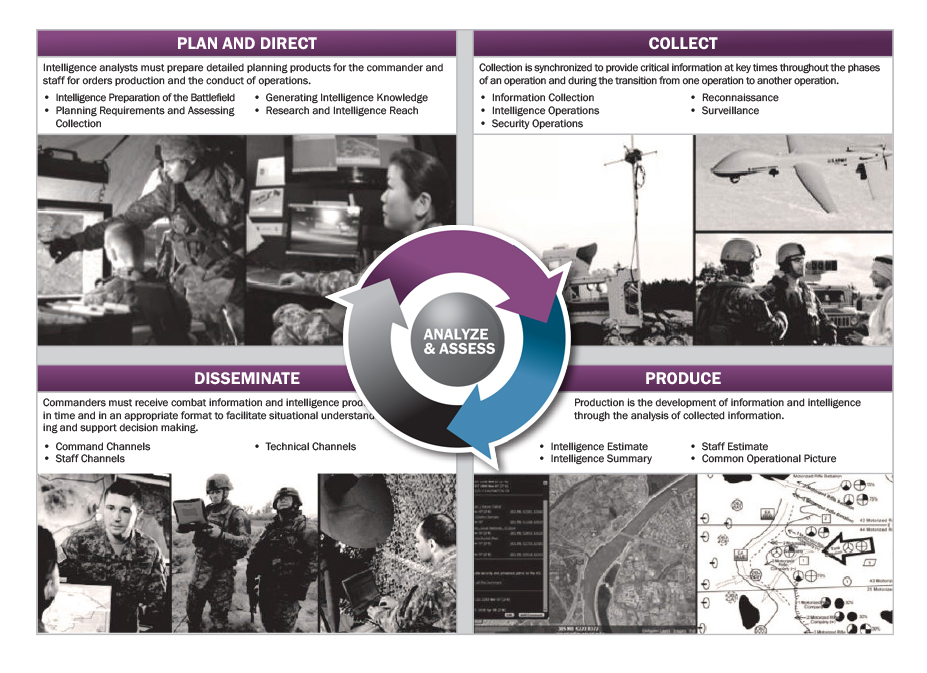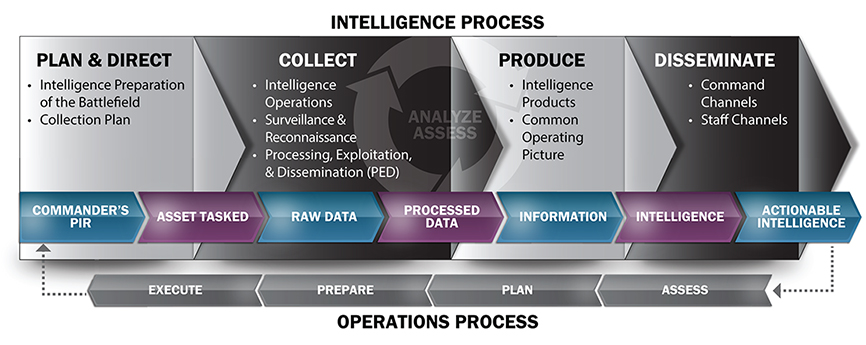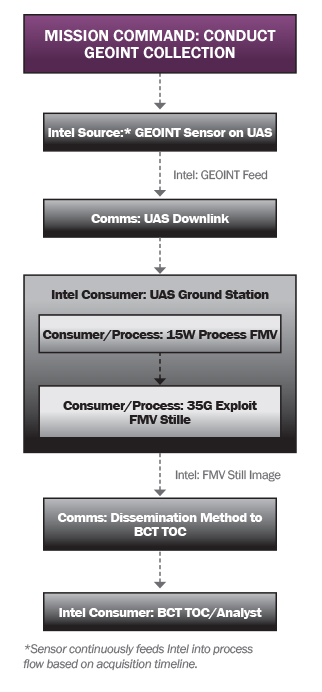Introduction
The increase in the use of intelligence, surveillance, and reconnaissance (ISR) systems over the past decade has created a significant increase of raw collection data available to the U.S. Army and intelligence community. Unfortunately, this surplus of data has also made it increasingly difficult to conduct efficient processing and analysis to produce timely combat information and actionable intelligence. Within the Army, this problem has sparked changes to intelligence-related force structure, development of new complex information systems, and other advancements, specifically in intelligence processing, exploitation, and dissemination (PED).
PED is a process that supports intelligence operations by converting and refining collected information for reporting to commanders, decision-makers, intelligence analysts, and other consumers through a collection of related functions [1]. The PED functions are crucial links between the collection asset and the information consumers in the continuous cycle to produce quality intelligence.
To meet the emerging needs of the Army and intelligence community, the U.S. Army Materiel Systems Analysis Activity (AMSAA) has initiated a PED modeling effort to increase the analytical capabilities of AMSAA’s tactical-level ISR simulation, the Fusion Oriented Command, Control, Communications, Computers, Intelligence, Surveillance, and Reconnaissance (C4ISR) Utility Simulation (FOCUS). This article discusses the current state and future direction of PED, the scope and use of FOCUS, and the PED modeling development effort.
PED Overview
PED is the transformation of raw collected data into usable information distributed for further analysis and/or use as combat information by commanders and staff. When broken down, the PED process is a collection of functions that fit into one of the following categories:
- Processing: Automated or human cognitive-based conversion of collection data into useable information.
- Exploitation: The refinement of raw data to provide information by trained personnel or automation.
- Dissemination: The distribution or reporting of relevant information in a format suitable for commanders, staff, analysts, and other consumers [1].
PED is a critical component of the Army Intelligence Process, which supports commanders by providing intelligence needed to support mission command and the commander’s situational understanding. As indicated in Figure 1, the process consists of four steps (plan and direct, collect, produce, and disseminate) as well as two continuous activities (analyze and assess) [2].

Figure 1: The Army Intelligence Process.
The Intelligence Process is powered by the commander’s Priority Intelligence Requirements (PIR) that are translated into a collection plan for the ISR assets. The assets collect raw data to satisfy the PIR; and the raw data are processed, exploited, and disseminated as usable information. The collection of information is continuously analyzed and assessed to produce intelligence and combat information to be disseminated to commanders and staff. Figure 2 illustrates the Intelligence Process as it flows from PIRs to actionable intelligence and the relationship to the Operations Process.

Figure 2: Intelligence Process and Operations.
As PED becomes a growing concern to the Army, the military publications and doctrine that describe and define PED are continuously updated to reflect the current state of the rapidly evolving intelligence and PED enterprises. With the advancements in network technology, the intelligence enterprise is evolving from the traditional intelligence “stovepipes,” where each intelligence domain (e.g., geospatial intelligence [GEOINT] and signals intelligence [SIGINT]) has a dedicated PED process, toward an integrated and distributed network. The distributed PED architecture will support multi-intelligence capabilities and provide continuous analysis with near-real-time collection asset tipping and cuing.
FOCUS: A Tactical-Level ISR Simulation
FOCUS is an AMSAA-developed, entity-level, event-driven, stochastic, ISR-centric simulation. It simulates ISR processes: sensor performance; tasking and collection; the exploitation and processing of data from all sources; the fusion of this information into tracks; and the communication of current predicted tracks to a visual simulation of entities and events in a three-dimensional (3-D) battle-space. FOCUS can be used to rapidly assess the performance of ISR systems in small, tactical-level vignettes in complex environments, such as urban and mountainous terrains. A typical use case is the comparison of a mix of aerial systems conducting searching and tracking missions using single or multi-INT sensors.
FOCUS represents entities at the platform (vehicle, aircraft, dismounted soldier, etc.) and sensor (electro-optical [EO]/infrared [IR], moving target indicator and synthetic aperture radars, SIGINT) levels. Behaviors such as movement, collection, acquisition, and communications are defined for each entity by the user when setting up the vignette. Behaviors can either be manually generated by placing waypoints on the terrain or by constructing a flow diagram of built-in, autonomous “missions” along with dynamic conditionals and events. Vignettes are built using an easy-to-use graphical user interface (GUI) that enables a user to quickly generate a scene, entities, and behaviors using point-and-click operations. FOCUS is capable of importing a variety of terrain formats, including both low (30–100-m interval) and high (1-m interval) resolution data. Buildings and other environmental features can be added to the terrain surface. A post-processing analysis toolkit is integrated into FOCUS to filter the output file and extract the desired results. The results can be viewed using the internal FOCUS graphs or exported for further spreadsheet analysis. Figure 3 provides a screenshot of FOCUS and sample results.

Figure 3: FOCUS Screenshot and Sample Results.
FOCUS includes the current sensor performance models. AMSAA is continuously improving the sensor representations and overall ISR process, including the ability to simulate Level 1 Fusion, the association of sensor measurements into tracks while maintaining fused position estimates, velocity estimates, and elliptical errors. Current applications of FOCUS include ISR sensor performance analysis; sensor coverage analysis; and tactics, techniques, and procedures (TTPs) comparative analysis.
A Model for Enabling PED Analysis
AMSAA’s modeling approach for PED includes the potential impact and measures of effectiveness (MoEs) produced by the model. The overall objective of the PED modeling effort will focus on the following questions:
- What are the key MoEs of a PED process implementation? – The methodology must be able to produce metrics that measure the effectiveness of the PED process in the execution of the Intelligence Process.
- What tradeoffs can be made in the PED implementation to influence the overall effectiveness of the PED process in the Intelligence Process? – The methodology must allow tradeoffs of PED architecture attributes and enablers that will alter the measures of effectiveness for that PED implementation.
Impact
The addition of a PED modeling capability into a tactical-level ISR performance simulation, such as FOCUS, provides numerous benefits to Army and Joint analysis and modeling and simulation (M&S). In particular, adding this capability:
- Enables PED-related analysis to inform materiel acquisition decisions. The FOCUS PED implementation will allow AMSAA to analyze the effectiveness of PED implementations to meet operational requirements.
- Supports trade analysis of PED architecture materiel components/enablers. The FOCUS PED implementation will allow trade studies on the various materiel components and “enablers” of a PED architecture (e.g., network, storage, cloud infrastructure, processing capability, intelligence tools, and number/experience of analysts). Each component/enabler would have an effect on the throughput of the architecture and possible effects on quality of the intelligence. This could also include assessment of emerging PED technologies and algorithms.
- Increases fidelity of ISR collection and tasking in current/future M&S. The FOCUS PED implementation will provide a more realistic depiction of information collection processes in M&S, which may significantly affect operational outcomes in scenario-based studies. Instead of scripted retasking of assets, dynamic tasking decision-making based on the results of the PED processes could occur.
PED MoEs
Metrics of a PED analysis capability will be realized as the modeling is tailored to meet the needs of the larger community. The following are potential MoEs:
- Current Situational Understanding vs. Threat Ground Truth Ratio. The intelligence collected over time creates a picture of the current threat for the commander. This MoE will provide a ratio of the number of threat entities acquired by the ISR systems vs. the ground truth number of threat entities over time. Variations of this MoE could incorporate the level of acquisition (e.g., detected, identified), a confidence in the threat location, and identification of high value targets.
- Number of Intelligence Requirements Satisfied/Answered. An Intelligence Requirement is information that is needed by a commander and staff to understand the adversary or other aspects of the operational environment. These requirements are defined as part of the plan and direct stage of the Intelligence Process and are answered through information collection. Given a set of Intelligence Requirements for a scenario, this MoE will provide the number of requirements answered over the course of the scenario, and with what confidence. Architecture tradeoffs could influence the time taken to answer the requirements.
Modeling Approach: PED Process Flow
As an expansion to FOCUS’s existing tasking and collection capabilities, the PED model would be represented as a process flow that integrates the raw collection by an asset with the processing, exploitation, and dissemination elements of the PED function and that allows dynamic links to the mission command structure (asset tasking). The PED process flow is constructed using a collection of generic “building block” processes, each of which is intended to be extended to model the specific PED elements in a tactical-level scenario. Table 1 defines each of the initial PED blocks and gives examples of a potential concrete implementation.
| PED “Building Block” | Definition | Examples |
| Source | An object that is capable of creating a piece of information/intel | GEOINT sensor, SIGINT sensor, human intelligence (HUMINT) collector, historical database |
| Intel Type | An information/intelligence item | Raw sensor feed, video, intel reports, products |
| Process | A process that can manipulate the information/intelligence or perform some function as part of the architecture | Automated processing, human analyst imagery exploitation, data fusion |
| Consumer | An object that is capable of receiving, performing processes, or holding information/intelligence data | PED node, commander, database |
| Communications | A process that transfers information/intelligence from a source to a consumer | Unmanned aerial system downlink, email, chat |
| Conditional Filters | A conditional test to allow for dynamic threads through the architecture based on the vignette state | Intelligence requirement met/not met, high-value individual (HVI) tracked |
| Mission Command Link | A link that activates the Mission Command Process Flow to dynamically change the maneuver or collection plan | Maneuver to area of interest, track HVI |

Figure 4: Notional PED Process Thread.
Most of the new functionality within FOCUS and system trade-offs will occur in the Process flow blocks by modeling complex processes and system capabilities. Potential Process flow blocks include the following:
- Information Systems – a system designed for managing, pushing, or broadcasting information/intelligence for a variety of recipients; these systems may also have tools that support the entire Intelligence Process.
- Human-Systems Integration – human-based processes are heavily dependent on the workload and experience of operators/analysts and have effects on the timeliness and quality of the information/intelligence produced. Most sensor data are processed and exploited by a human at some point during the PED function.
- Applications/Tools – tools for processing/exploiting using thin client or thick client tools.
- Data Fusion – correlating and performing state estimation of target detection data to form tracks (i.e., Level 1 Data Fusion, a current FOCUS capability), aggregating multiple objects to identify groups/units (i.e., Level 2 Data Fusion, future capability).
Figure 4 illustrates a notional PED process flow, from the ISR collection asset through a consumer via a communications system to a commander. The commander can then dynamically retask the ISR collection systems. The final methodology would allow multiple layers of this process using varying combinations of ISR systems, communications systems, PED nodes, and commanders. The process would allow insertion of additional processes into the flow as more complex procedures are developed.
Conclusion
PED analysis has quickly emerged as a critical component of any analytical study of ISR systems. AMSAA is preparing for the future analysis needs of the Army and Joint intelligence communities by developing a PED modeling capability within FOCUS. Through the use of this tool and the evolving PED implementation, a new capability is being developed to model the Intelligence Process with high fidelity, enabling trade space analysis of PED-related systems and processes.
References:
- U.S. Army Intelligence Center of Excellence. “Processing, Exploitation, and Dissemination (PED) Requirements Supporting U.S. Army Intelligence Collection Capabilities (Version 4.0).” January 2014.
- Headquarters, Department of the Army. “ADRP 2-0 Intelligence.” August 2012.


